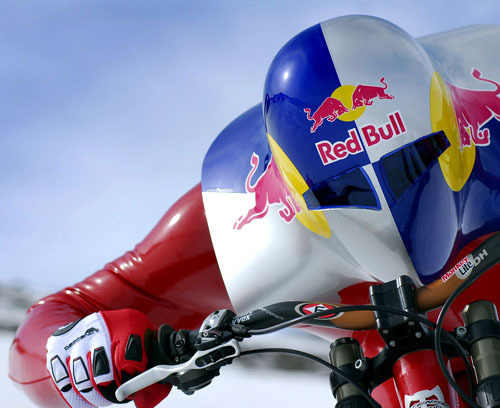 Austria’s Markus Stoeckl, 33, set a new world record for series mountain bikes in the Chile’s Alps when he hit a speed of 210.4 km/h. He shattered an eight-year-old record by an incredible 23 km/h. Stoeckl, member of Team MS Intense Racing, is one of Shimano’s official test riders. In his successful record attempt he relied completely on components provided to him by Shimano Europe like a Saint crankset and rear derailleur and the new Deore XT disc brakes with 203mm rotors for front and rear that gave him the controllability and brake power to stop safely after this amazing speed.
Austria’s Markus Stoeckl, 33, set a new world record for series mountain bikes in the Chile’s Alps when he hit a speed of 210.4 km/h. He shattered an eight-year-old record by an incredible 23 km/h. Stoeckl, member of Team MS Intense Racing, is one of Shimano’s official test riders. In his successful record attempt he relied completely on components provided to him by Shimano Europe like a Saint crankset and rear derailleur and the new Deore XT disc brakes with 203mm rotors for front and rear that gave him the controllability and brake power to stop safely after this amazing speed.
For a video of the run, click here
For years there was little news to report about speedbikes on snow, the world’s fastest vehicles without propulsion. In the 1990s, there had been a number of classic, unforgettable duels between two Frenchmen, Eric Baronè und Christian Taillefer, who set a series world speed records as they sped down the French Alps clad in rubber suits and aerodynamic helmets with spoilers attached to their bodies while riding on futuristic speeding projectiles that had only a faint resemblance to bicycles. The only other racer who came even close to keeping up with the French duo was a young man from Kitzbühel, Markus Stoeckl. Because he could not afford an expensive prototype at the time, he rode in the series bike class and managed to set a world record in that category at 187.013 km/h at Les Arches in 1999. Eric Baronè’s record in the prototype class of 222 km/h had stood since it was set at the same time.
After that, interest in France dropped off, as Markus Stoeckl explains: no races, no championships, no runs. Since then, the giant nicknamed “Hercules“ (he weighs 100 kg, and stands 1.90 metres tall) has taken part in “normal“ downhill races, founded his own company, and set up his own World Cup team “MS Intense Racing“. He was on an assignment in Portugal when he found out that the old speed track in La Parva, Chile was being renovated. He did not hesitate and quickly jumped on a plane to South America after hurriedly packing his old helmet, speedsuit and his new “Intense M6“ bike, fully equipped with Shimano components.
Just seven days later, on Friday, 14 September at 11:18 a.m., Stoeckl was standing at the highest-possible starting point directly beneath the cliffs in front of a 2000 meter long and 45-degree steep slope. The conditions for the record run were far from ideal. Because South America’s springtime weather had melted away much of the snow alongside the piste, shrinking it to a narrow strip set up between bare mountain cliffs, it was not possible to gradually raise the starting point for test runs. The final test run took place from a spot that was hundreds of metres below the starting point where a top speed of 178 km/h was recorded.
Because the protective visor on his helmet kept fogging over, Stoeckl was also forced to hold his breath for the 40-second run. “I knew that this would be my only chance,“ he said. The record run went off without a hitch. There were no problems whatsoever and despite hitting a speed of 210.4 km/h it all seemed somehow unspectacular.
Markus Stoeckl has now tasted success and he wants to try to break the other age-old records set by Eric Baronè. Fernando Habash, who is in charge of the La Parva ski resort, has promised he would have a course suitable for records set up.



